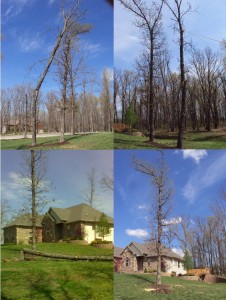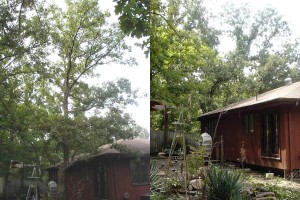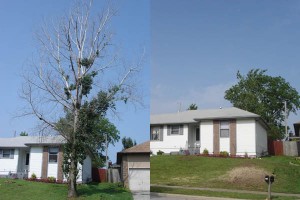Tree Solutions can safely and cost effectively remove trees over houses, decks, pools, and all your property and landscape in the dropzone of the tree. No truck access? No problem. We can do the job when others can’t even get to the job.
Tree Solutions Priorities:
The safety of our work crew, our clients, and any bystanders.
The safety of your property, your house and buildings, fences, driveways and walks, landscaping, even the turf of your lawn.
Our Methods
Each tree presents different options and difficulties in its removal. We evaluate the tree, and recommend the least expensive option for its safe removal.
Please take a minute to look over the before and after photos below of some sizeable and challenging tree removals we’ve completed. Tree Solutions has the knowledge, experience, and tools to complete your tree removal project efficiently.
Pictures are clickable for large view.
Mostly Broken Hung Up Hickory
A column of decay encompassing three quarters of the trunk allowed the weakened Hickory stem to partially fail in a high wind event. Only a small 2 inch by 6 inch strip of undecayed wood was keeping the hickory top aloft, and a six inch gap was visible at the point of the break.
The Hickory broke over into a smaller Oak tree, and hung suspended there, aimed toward the house and landscaping, just waiting for another big wind to send it crashing to the house.
Two separate anchor points, and a mechanical advantage system were used to raise the tree upright, and hold it stable while felling cuts were placed. The broken tree was then pulled safely into the open lawn and away from the house and landscaping. Even the Oak tree which the Hickory was hung up in had no additional damage in the process of getting the Hickory free of entanglement and safely felled.
Warning: Do not attempt to work on partially failed or hung up trees (or especially both), without proper experience, equipment, planning, and execution. Trees like this one are very dangerous, and the weights and forces involved can easily maim or kill in the event of an error or failure.
Precision Felling Dead Poplar Tree
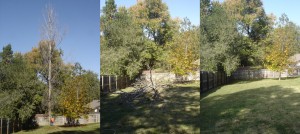 This tall dead Poplar tree had space to fell it whole, but no room for error without damaging the young Tulip Poplar or the privacy fence. Tree Solutions felled it perfectly, without breaking a single twig of the Tulip Poplar, or a single board of the fence. When you need a big tree to fit in a little space, Tree Solutions are the ones to call. In the before section you can see Dean Hudson preparing to fell the tree, and he appears tiny next to the 70+ foot Poplar.
This tall dead Poplar tree had space to fell it whole, but no room for error without damaging the young Tulip Poplar or the privacy fence. Tree Solutions felled it perfectly, without breaking a single twig of the Tulip Poplar, or a single board of the fence. When you need a big tree to fit in a little space, Tree Solutions are the ones to call. In the before section you can see Dean Hudson preparing to fell the tree, and he appears tiny next to the 70+ foot Poplar.
Very Large Dead Elm Tree
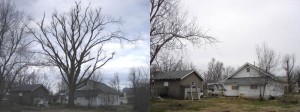 This very large, very dead Elm tree turned out to be a very labor intensive tree removal. A bucket truck was used to remove in small sections limbs over the house and garage, and the tree was then felled into the yard. When it hit, it exploded into a flying mass of limbs, brush, and bark. Several weak spots in main limbs were revealed on impact as they split or broke entirely, and the internal decay became evident. Any dead tree should be removed as quickly as possible, as the passage of time only increases the danger and cost of tree removal.
This very large, very dead Elm tree turned out to be a very labor intensive tree removal. A bucket truck was used to remove in small sections limbs over the house and garage, and the tree was then felled into the yard. When it hit, it exploded into a flying mass of limbs, brush, and bark. Several weak spots in main limbs were revealed on impact as they split or broke entirely, and the internal decay became evident. Any dead tree should be removed as quickly as possible, as the passage of time only increases the danger and cost of tree removal.
Large Multi-Stem Honey Locust
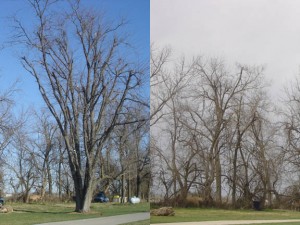 This big honey locust had five co-dominant leads, plenty of included bark, and lots of huge thorns.
This big honey locust had five co-dominant leads, plenty of included bark, and lots of huge thorns.
The tree was removed with no damage to the thin concrete drive, fencing, or large electric box out of view on the left.
All the wood chips were composted, and the rest of the tree was re-cycled into fence posts and firewood.
The stump was ground out, the grindings were cleaned up and hauled away, fresh topsoil was brought in, and sod was put down. Without seeing the before picture, you’d never know a tree was there.
White Oak Over House
This White Oak was removed to make way for a new patio. Most of the limbs and top were lowered on rope to keep the house below safe from damage. The tree was successfully removed, and the stump ground out with no damage.
The homeowners elected to do all the cleanup themselves, so all the brush was piled for ease of cleanup, and all the branches and logs were cut to firewood length and stacked. Taking care of the cleanup themselves saved the homeowners a couple hundred dollars on this job. This option is always available to you when cost is a factor in being able to afford to have work done.
Tulip Poplar Removal
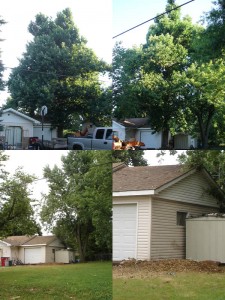 This Tulip Poplar tree is a perfect example of the wrong tree in the wrong spot. It’s root flare was moving the garage foundation, and it’s trunk was rubbing on the eve of the house. Tulip Poplar is a very fast growing, very large tree, and to complicate matters their wood is very brittle. Having one next to a house, with half of it’s crown growing over the house creates a potentially hazardous situation in high winds or ice.
This Tulip Poplar tree is a perfect example of the wrong tree in the wrong spot. It’s root flare was moving the garage foundation, and it’s trunk was rubbing on the eve of the house. Tulip Poplar is a very fast growing, very large tree, and to complicate matters their wood is very brittle. Having one next to a house, with half of it’s crown growing over the house creates a potentially hazardous situation in high winds or ice.
This specific tree was a fairly techincal sectional rigging removal. At over 70′ in height, with many large limbs over the house, garage, and shed, nearly all the limbs and tops were lowered safely to the ground on ropes. One low limb extended half the length of the house, parallel to the roof, and very close to it. It was removed by balancing the limb on two legs of the lowering line, and pulling it clear of the house once it was cut with another rope.
Once the tree was down to half it’s original height, the stem was felled against it’s lean with a pull rope and wedges. The stump was ground to complete the removal, and the house is now safe from the brittle Tulip Poplar tree.
As usual, Tree Solutions completed the removal with no damage to anything, and nothing larger than twigs contacting the house and garage.
Sycamore Leaning Over Barn
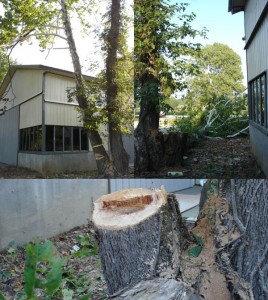
This co-dominant sycamore lead is leaning heavily toward the new barn, with most of it’s canopy over the barn.
The before pic was taken after the tree was climbed and a few limbs roped down, and a pull line installed high in the tree to help pull it over without touching the barn.
The trunk was strapped to prevent barber chair (the tree splitting as it falls), and it was felled cleanly into the lawn without touching the barn. The Sycamore tree was pulled over using a mechanical advantage system anchored to a truck, and a fine bit of felling work.
Though healthy, these trees would have begun to decline from construction damage, and would have been easier to remove before the barn was built.
White Poplar Removal
This White Poplar was in drastic decline, most likely due to the root pruning the next door neighbor did several years prior. Most of the major roots were cut off 6-8′ from the base of the tree on one side, and the tree was never able to recover from the damage to it’s root system.
Par for the course, this tree leaned (only slightly) directly away from it’s needed fall direction. It was climbed to remove limbs from the backside of the intended fall direction, and install a pull line to help bring the tree over.
It was then directionally felled in front of the house, with no damage to anything. The stump and many surface running roots were ground out, leaving the yard ready for a new replacement tree.
Red Maple with Girdling Root
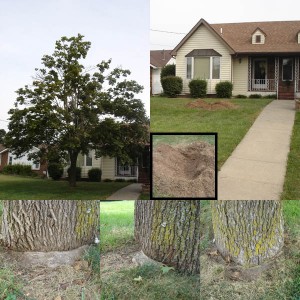 his Red Maple tree is the victim of improper planting. It was taken directly from it’s nursery pot and placed in the ground with almost no preparation, because the roots system grew in a perfect circle around the trunk, exactly where they would have been in the nursery pot. After this tree was removed, the stump was ground out as completely as possible to allow a replacement tree to grow in the same spot. The stump hole was left almost ready for planting.
his Red Maple tree is the victim of improper planting. It was taken directly from it’s nursery pot and placed in the ground with almost no preparation, because the roots system grew in a perfect circle around the trunk, exactly where they would have been in the nursery pot. After this tree was removed, the stump was ground out as completely as possible to allow a replacement tree to grow in the same spot. The stump hole was left almost ready for planting.
To prevent this from happening as your nursery grown tree matures, visit our tree planting page before you plant. The problem of a girdling root can be corrected in young trees, by a root flare excavation and minor root pruning. In more mature trees, removing a girdling root can cause enough damage to kill the tree, leaving removal and replanting as the only option. This tree was 80% encircled by the girdling root, and it’s trunk tightly constricted. This was the cause of the die back in the crown, and would have killed the tree in time.
Crabapple, Redbud & 3 Silver Maple Removals
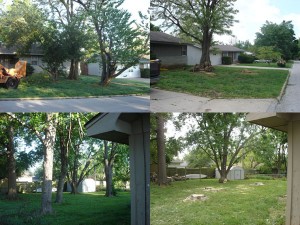 On this job we removed a Crabapple and a Redbud in the front yard, leaving only the large Honey Locust.
On this job we removed a Crabapple and a Redbud in the front yard, leaving only the large Honey Locust.
The back yard was much more difficult. We removed 3 Silver Maple trees, each of them was climbed and removed in sections. Lots of breakage hung up in the crown, and limbs overhanging low voltage power lines, chain link fences, and the house. Several limbs were lowered on ropes, and the tree on the near left (before) was pulled over against it’s lean with specialized rigging and saftey lines. All five removals and a trim of a large pin oak of it’s breakage, and all cleanup was completed in one day.
Silver Maple Removal
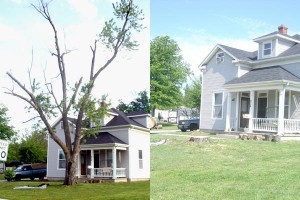 This Silver Maple tree was dying, decaying from the inside out, and threatening to fall on the homeowners house. It was in truly horrible condition, and should have been removed long ago.
This Silver Maple tree was dying, decaying from the inside out, and threatening to fall on the homeowners house. It was in truly horrible condition, and should have been removed long ago.
Whether or not the dead lead was climbable was in question, but I ended up using two tie ins, one on each green lead, and climbed high enough up the dead lead to pull the top off of it, safely landing in the yard with no damage.
The rest of the job was relatively easy, and the tree was down and cleaned up in no time, with no damage to the new Red Maple, the tarp covered koi pond, or the house.
White Oak Removal
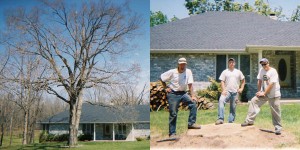 This enormous White Oak tree is the largest removal we’ve done to date. It was removed due to an expanding crack in the main crotch. The taller lead was aimed directly at the house, and would have done catostrophic damage if it had fallen. In order to climb it safely, a log chain was used to chain the two leads together. Once it was secured, the tree was removed in sections. When it was finished the tree had held almost 6 cords of firewood, and the stump measured 49″ x 46″.
This enormous White Oak tree is the largest removal we’ve done to date. It was removed due to an expanding crack in the main crotch. The taller lead was aimed directly at the house, and would have done catostrophic damage if it had fallen. In order to climb it safely, a log chain was used to chain the two leads together. Once it was secured, the tree was removed in sections. When it was finished the tree had held almost 6 cords of firewood, and the stump measured 49″ x 46″.
Honey & Black Locust Removals
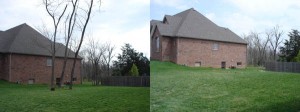 Here are 3 Honey Locust trees, and a Black Locust tree with a few small saplings. The one on the right leaned heavily towards the house (out of view on right), and was tall enough to reach it, so it was climbed and topped before the stem was felled. The middle tree also leaned towards the house, but was easy to pull over sideways to the lean with a rope. The left tree grew straight up, and was an easy drop.
Here are 3 Honey Locust trees, and a Black Locust tree with a few small saplings. The one on the right leaned heavily towards the house (out of view on right), and was tall enough to reach it, so it was climbed and topped before the stem was felled. The middle tree also leaned towards the house, but was easy to pull over sideways to the lean with a rope. The left tree grew straight up, and was an easy drop.
The Black Locust was leaning back over the neighbors privacy fence, but was easy to pull over with a rope, due to it’s small size. Nothing difficult here, but it was a very thorny job.
Tulip Poplar w/ power lines
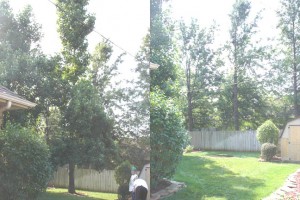
Tulip Poplar removal with high voltage and low voltage on 2 sides, including stump grinding with full cleanup and topsoil refill.

